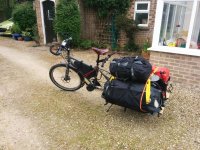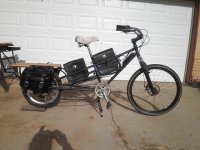Hi everybody and happy new year,
this year I planing a 10000km ebike tour from Spain to Sweden (and back) and will be modifing my bike a lot.
2016 I already did a 5000km ebike tour from UK to Spain with a Surly Big Dummy (https://www.instagram.com/opendocumentary/) with a BBSHD and after around 3000km the controller broke. So I had to bike around 400km without motor (till I got a replacement BBS2) with a total weight of maybe around 150-200kg (most of the luggage is camera gear) and that close to the alps.
So for this tour I will be changing a few things:
300w Solar Power
At least one brushless hub motor (for using regen a lot)
My main goal would be to use regen a lot because on the other tour I was really bushing the breaks to the limit and I want to have 2 motors so that I have one as backup.
So what would be the best motor for regen?
Better 48V or 52V setup?
I don't have to go fast with my setup! I have to go far
I will be going with the Phaserunner (http://www.ebikes.ca/shop/electric-bicycle-parts/controllers/c-phaserunner.html) as a Controller.
Was thinking of going with the GrinHub (http://www.ebikes.ca/shop/electric-bicycle-parts/motors/grinhub-sl.html) but not sure if that one is strong enought for my weight (because of Bearing Size and Life) and it is also killing my budget
But what version would be better for regen (12.5 or 10.5 or 8 rpm/V) ?
Or what about the MXUS Rear Hub MotorMX3006RC (http://www.ebikes.ca/shop/electric-bicycle-parts/motors/mx3006rc.html) ?
Or is there a better option for efficency + regen?
Maybe I will be keeping the BBSHD but not sure.
Thanks for your help!
Chris

this year I planing a 10000km ebike tour from Spain to Sweden (and back) and will be modifing my bike a lot.
2016 I already did a 5000km ebike tour from UK to Spain with a Surly Big Dummy (https://www.instagram.com/opendocumentary/) with a BBSHD and after around 3000km the controller broke. So I had to bike around 400km without motor (till I got a replacement BBS2) with a total weight of maybe around 150-200kg (most of the luggage is camera gear) and that close to the alps.
So for this tour I will be changing a few things:
300w Solar Power
At least one brushless hub motor (for using regen a lot)
My main goal would be to use regen a lot because on the other tour I was really bushing the breaks to the limit and I want to have 2 motors so that I have one as backup.
So what would be the best motor for regen?
Better 48V or 52V setup?
I don't have to go fast with my setup! I have to go far
I will be going with the Phaserunner (http://www.ebikes.ca/shop/electric-bicycle-parts/controllers/c-phaserunner.html) as a Controller.
Was thinking of going with the GrinHub (http://www.ebikes.ca/shop/electric-bicycle-parts/motors/grinhub-sl.html) but not sure if that one is strong enought for my weight (because of Bearing Size and Life) and it is also killing my budget
But what version would be better for regen (12.5 or 10.5 or 8 rpm/V) ?
Or what about the MXUS Rear Hub MotorMX3006RC (http://www.ebikes.ca/shop/electric-bicycle-parts/motors/mx3006rc.html) ?
Or is there a better option for efficency + regen?
Maybe I will be keeping the BBSHD but not sure.
Thanks for your help!
Chris



